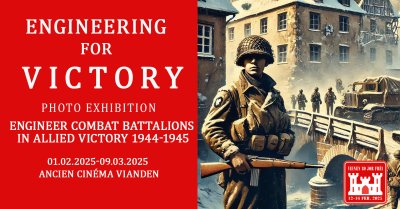Engineering for Victory.
The Role of Engineer Combat Battalions During the Liberation of Luxembourg, the Battle of the Bulge, and military operations in Germany
Exhibition in Ancien Cinema: 01.02.2025 – 09.03.2025
The Allied advance through Western Europe during World War II relied heavily on a combination of strategic planning, combat operations, and engineering ingenuity. Engineer Combat Battalions (ECBs) played a critical role in ensuring the success of operations during the liberation of Luxembourg, the Battle of the Bulge, and the final push into Germany. Their multifaceted contributions—ranging from infrastructure repair to direct combat support—proved indispensable to the Allied victory.
The Liberation of Luxembourg
Luxembourg was liberated in September 1944 as part of the Allied advance following the breakout from Normandy. Despite its small size, Luxembourg was of strategic importance due to its location at the crossroads of key transportation routes and its proximity to the German border.
The retreating German forces left a trail of destruction, destroying bridges, mining roads, and sabotaging infrastructure. The ECBs were tasked with restoring mobility for advancing Allied forces. Units like the 1104th Engineer Combat Group rebuilt roads and bridges and removed mines and other obstacles. Their efforts enabled the rapid movement of supplies, troops, and vehicles necessary for sustaining the Allied advance.
The Battle of the Bulge
The Battle of the Bulge, launched by Germany on December 16, 1944, was a desperate attempt to halt the Allied advance by cutting through the Ardennes region. The ECBs played a pivotal role in delaying the German offensive, defending critical positions, and enabling the Allies to regroup and counterattack.
One of the key contributions of the ECBs during this battle was the destruction of bridges and the creation of roadblocks to slow the German advance. Engineers destroyed bridges, laid mines, and felled trees to create roadblocks, forcing the Germans to reroute and lose precious time. Their work was hazardous, often conducted under enemy fire and in freezing conditions. Despite these dangers, the engineers demonstrated remarkable ingenuity and courage.
In addition to their defensive operations, ECB units often found themselves engaged in direct combat. The 291st Engineer Combat Battalion commanded by Colonel David E. Pergrin, blowing up bridges and fighting as infantry in helping stunt the German advance towards Antwerp. Scouting parties of the 291st discovered 17 survivors of the Malmedy massacre on 17 December 1944. After nearly a month of gruelling counter measures against the initial Panzer forces, the battalion's C Company returned to Malmedy to discover the bodies of 86 murdered US GIs frozen under a thick blanket of snow on 14 January 1945.
As the tide turned in favour of the Allies, the ECBs shifted their focus to rebuilding bridges and clearing roads to support the counteroffensive. Their efforts ensured that Allied forces could rapidly regain lost ground and push the Germans back into their territory.
Military Operations in Germany
The final phase of the war involved the invasion of Germany, a campaign marked by intense fighting and significant logistical challenges. The ECBs were instrumental in overcoming these obstacles, enabling the Allied forces to maintain their momentum and secure victory.
One of the most critical tasks undertaken by the ECBs during this period was the construction of temporary bridges over rivers such as the Rhine. The crossing of the Rhine was a major milestone in the Allied advance, and the ECBs played a vital role in its success. The 291st Engineer Combat Battalion played a pivotal role in the Allied campaign to cross the Rhine River at Remagen in March 1945. This crossing, one of the most significant events of World War II, marked the first time Allied forces breached the Rhine, Germany's last major natural barrier.
Another example was The 540th Engineer Combat Regiment, which constructed pontoon bridges towards the Roer river that allowed Allied forces to cross the river under fire, enabling a rapid and coordinated assault into Germany.
Beyond bridging operations, the ECBs cleared minefields, repaired roads, and restored railways, ensuring that supplies and reinforcements reached the front lines. They also built prisoner-of-war camps and temporary facilities to support the logistical needs of the advancing armies.
As the war neared its end, the ECBs continued to support both combat and post-combat operations. They cleared rubble and repaired infrastructure in liberated towns, preparing these areas for the transition to peacetime governance. Their work was essential not only to military success but also to the rebuilding of Europe in the aftermath of the war.
